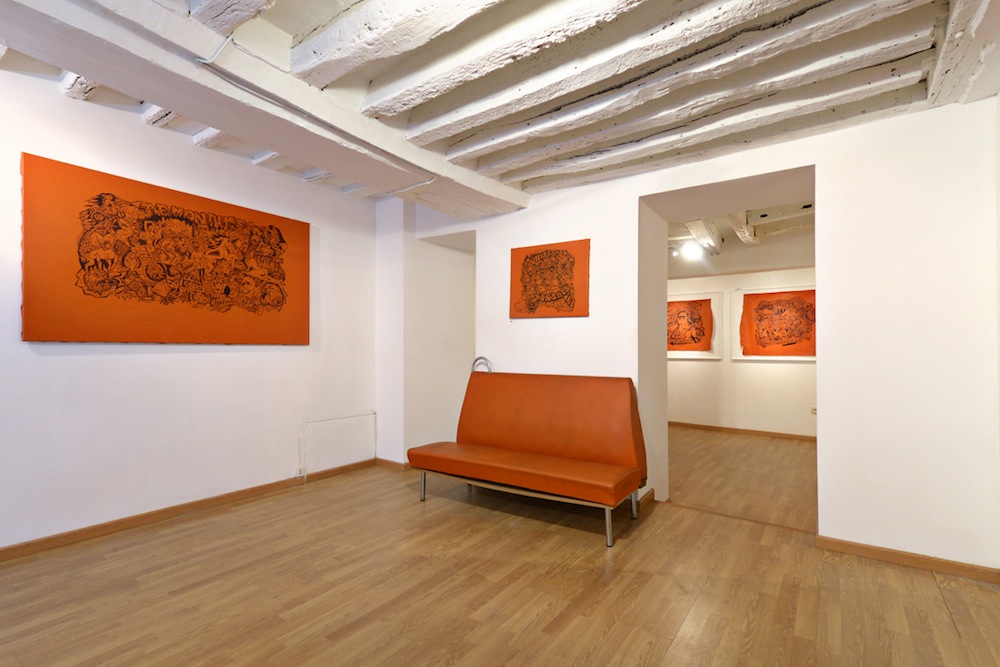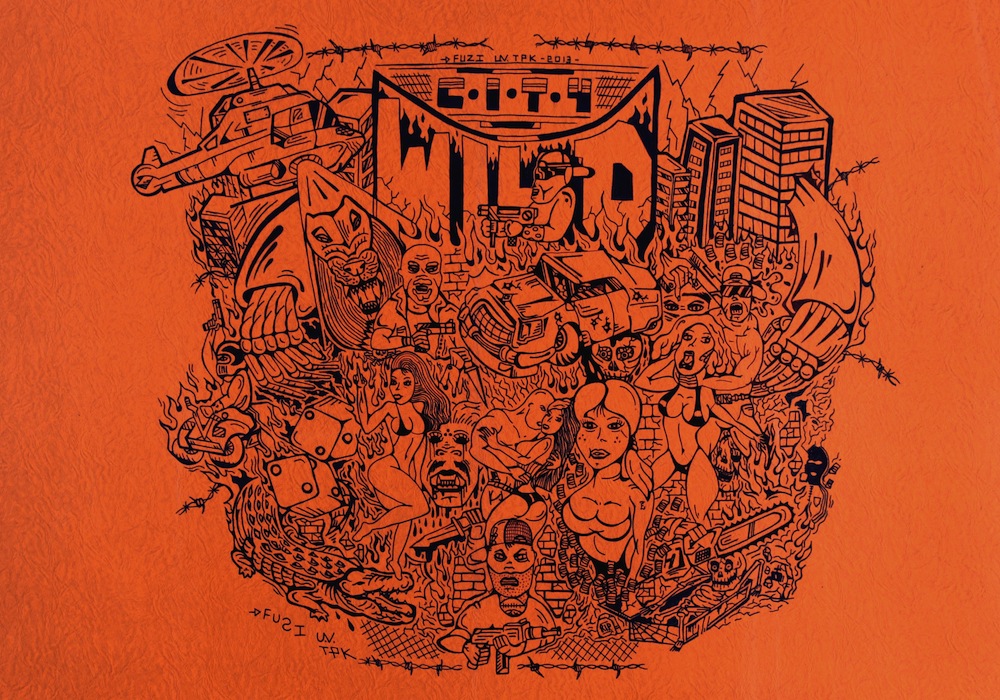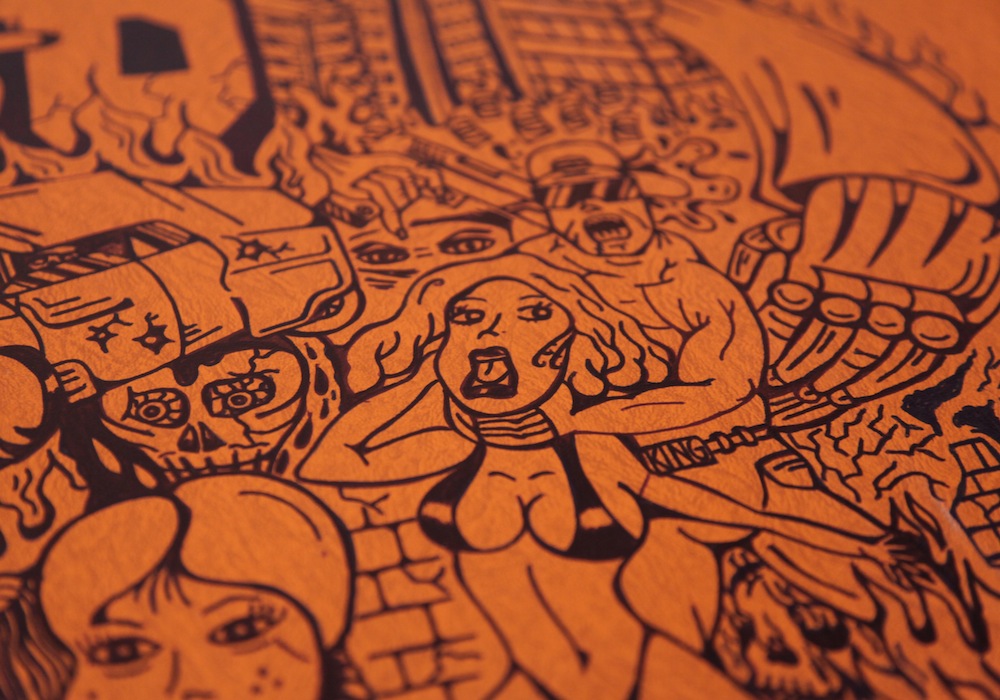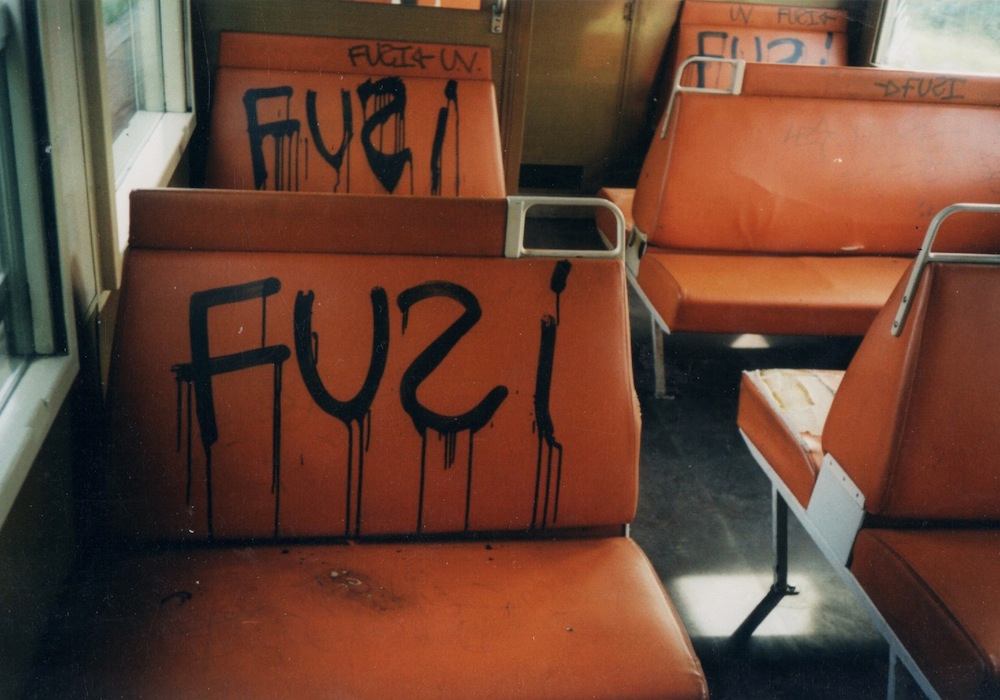
French artist FUZI UVTPK has become famous for his tattoos, inking severed heads, wild women and thug horses on clients such as Os Gemeos, Diplo, Justice and, most controversially, Scarlett Johansson. But long before FUZI became internationally recognized for his tattoos, he and his crew, UV (ULTRA VIOLENT), were notorious in France.
In the mid-1990s, he and his crew would take the Saint Lazare metro line from the western suburbs into Paris, and leave destruction in their wake. Thick black marker tags dripped down smooth metal doors; initials were scribed into glass windows; and the bright orange vinyl seats were slashed with razors and knives.
During this time, FUZI created a form of graffiti known as Ignorant Style. “My friends and I were wild and free, and I wanted to create a style that expressed that feeling,” FUZI explains. “Ignorant Style is a reaction to the standardization of graffiti. You write your name how you want, and where you want. There are no rules.”
His new exhibition, Devoration, is a testament to that time, for which he used simple rollerball pens to depict how he felt when he and his crew controlled the metro, and canvases made out of orange vinyl ripped from the same seats he used to write on. In collaboration with KRINK, a limited-edition bilingual book was published for the exhibition, which features a long interview with curator Thibault Choay. I flew to Paris for the opening of the exhibition, where I spoke to FUZI about some of the themes in the exhibition and book.

What is the meaning of the title of your new exhibition, Devoration?
It is a word used by gypsies in the south of France. They use it to describe their attitude toward drugs—it’s a mix between adoration and being devoured. It totally fits me. I have this thing I can’t fight against, a thing that feeds me as much as it eats me. It started with graffiti and now it has taken me in different directions.
And one of the directions was fine art.
Yes. I used to be so into graffiti that no other kind of art existed. But as I got older, I realized there were other things out there, and I wanted to know more. I had a limited education because I dropped out of school to paint trains, so apart from a few cliché names, I knew nothing at all. I started going to museums and discovered new artists and movements. One of my first shocks was Naïve Art and the theories of Dubuffet. I actually found similarities between this and the Ignorant Style. You can do just whatever you feel like! So I jumped into painting, sculpting, writing. All of a sudden, I had a clear conscience and no inhibitions. Then I went on learning, sharpening my tastes, and I started liking other movements also, like Expressionism. But the main point was that I could use any medium to express myself, and I could do so with the same approach that I had with graffiti, which was to follow my own rules. So I worked by myself, in improvised workshops, garages, shelters, and I tested everything—painting, sculpting, engraving. I was ecstatic, and wanted to try everything. That’s when I started tattoos.

You have continued to make tattoos. What about tattoos moved you?
I think it was because I found a lot in common between tattoos and graffiti—the street references, the ritual, the marginal or illegal practice, the mystery and the ostracism. I was very intrigued by the tattoo culture, and I read every single book on the subject. I learned its history, the famous names from the past and present, etc. But I was only really interested in prison tattoos, sailor tattoos, and gang tattoos. They were more strong and to the point, and just like in graffiti where I prefer to see a black tag dripping down the inside of a train car than a colorful piece. The tag has strength and soul. It really says something. So I drew inspiration from these kinds of tattoos, but I created my own Ignorant Style.
How did Ignorant Style come to be?
So in 1996, UV was everywhere—on the streets, subways and trains—and people were upset because we had a different style and painted over everyone else. As a reaction, guys completely denigrated our work. Basically the criticism was, “Yes, you guys are everywhere but you can’t paint, the technique is crap, it’s like you’re writing with your left hand, you’re just stupid vandals.” Nobody understood what we were trying to do. This is actually a frequent phenomenon in the history of art in general. When something different emerges, there‘s usually a general outcry from the establishment. It’s always easier to follow the trend. So in 1996, we traveled to Rome to paint the subways, which were not buffed yet. I went so nuts when I saw all those painted trains running—it was like our own New York! I made throwups over everyone else; we destroyed all the insides. And a bit later, a guy from over there came to Paris and used this term “Ignorant Style” to describe our approach. It reached my ears and it really left a mark on me. I finally had a name for the movement.

How does that period of time—the height of UV and the emergence of Ignorant Style—relate to your present exhibition?
Devoration is a celebration of this period. It’s about the time I spent with my crew inside the trains, which was a kind of studio for me. Ignorant Style was born on the seats of these trains, and this is why I used the leather from the seats as the material for the canvases in this exhibition. I am expressing myself in different ways now, but the meaning is the same. My work has always been about freedom and will continue to be.

